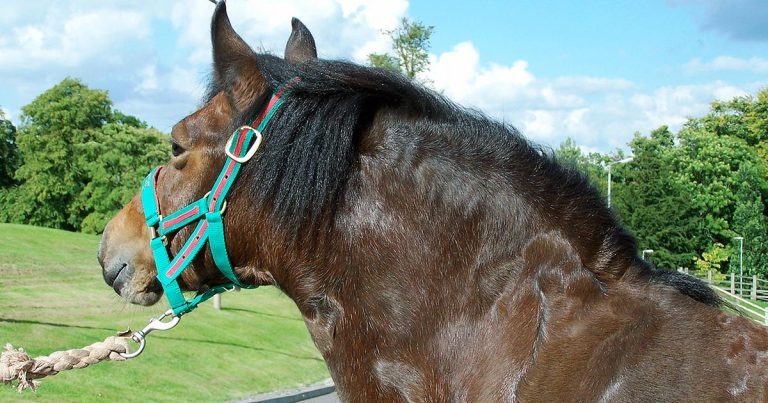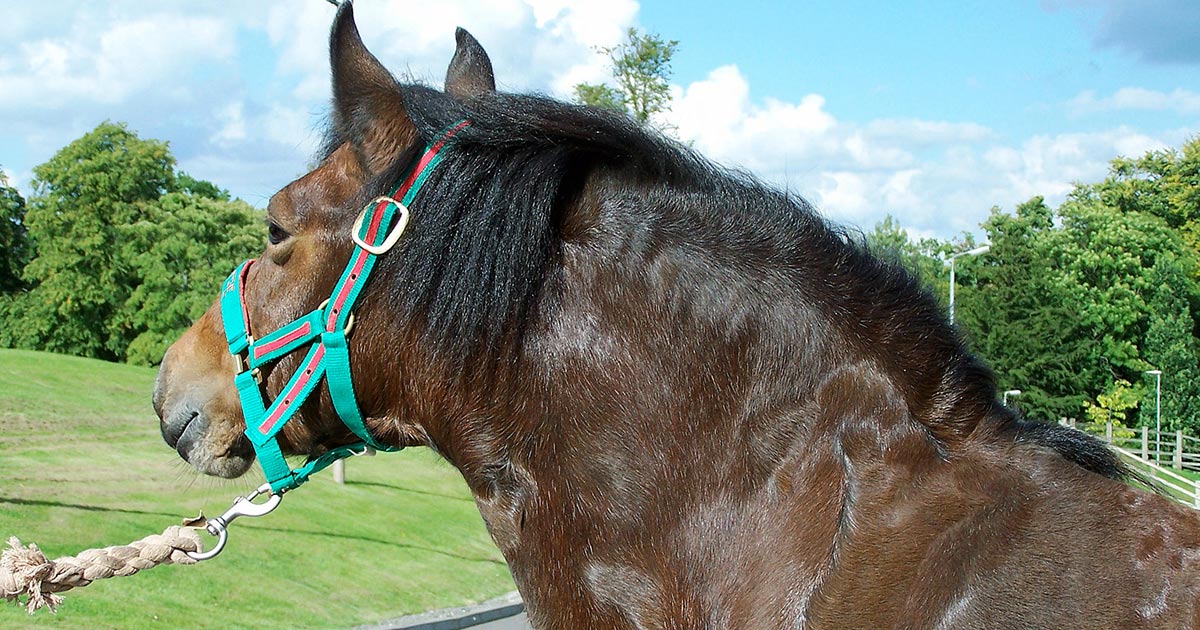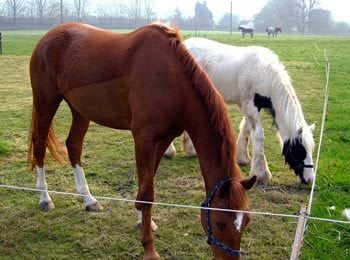27 Aug 2018
Managing obesity-related equine laminitis: part 2
David Rendle, in the second of a two-part article, highlights a one health approach to tackling this condition in horses.

Figure 1. Although estimates vary, it would be reasonable to assume 50% of the UK equine population is overweight or obese.
Obesity and insulin dysregulation are important factors in the development of laminitis – a condition that has a major impact on the welfare of horses.
Management of obesity is complex. The first part of this article outlined specific measures that should be taken to manage obesity – this part will focus on monitoring, pharmaceutical treatments and education of the owner, using experiences in other species and the management of childhood obesity.
The high rate of relapse in obesity in both children and pets suggest parents/owners have a high tendency to respond to withdrawal behaviour, or they give in to their co-dependence and craving for affection from their child/pet. In dogs, half of 61% that initiate a weight loss regimen successfully complete it1,2, and approximately half of dogs that successfully reach goal weight subsequently regain weight. Obese pet dogs that successfully lose weight and maintain the weight are the minority3.
Obesity epidemic
It is well recognised rates of obesity in people and companion animals are increasing. Data published by the World Health Organization in 2014 indicated 28.1% of adults in the UK were clinically obese, with a body mass index greater than 304.
In horses, rates of obesity are likely to be at least as high as they are in humans or dogs (Figure 1). It has been suggested obesity in horses may present an even greater welfare concern than in other species, as obesity is less pronounced in such large animals and obesity has become so widespread that overweight horses are perceived as “normal”10.

In pleasure riding horses in Scotland examined in 2005, 45% of 319 horses of various breeds were considered to be obese11. Poor agreement occurred between owners’ and researchers’ assessment of condition score – particularly in obese horses. Of the 144 horses considered by researchers to be obese, only 53 were judged obese by their owners.
Non-professional owners of 160 horses from Leicestershire and Nottinghamshire who completed a questionnaire in 2008 reported 20.6% of horses were overweight12. However, evaluation of 15 of these horses by a researcher indicated poor agreement between owner and researcher assessment, with the owner’s median condition score being 0.7 out of 5 lower.
If this difference was extrapolated across the whole study population, 54% of horses would have been considered obese.
In another questionnaire study of owner-reported body condition score across the wider UK equine population, the prevalence of obesity was 31.2% (247 out of 792). Estimates of obesity in the equine population of south-west England were 27% and 35% during winter and summer, respectively13.
A study of 446 non-laminitic ponies aged seven years or older kept within 50 miles of the RVC revealed 72% to be overweight or obese14. Unfortunately, none of these studies give an entirely accurate estimate of the prevalence of obesity across the whole of the UK equine population, but the consistent take-home message is clear.
One health issue
Obesity in pets has been considered a model for obesity in children15 and, therefore, obesity is a true one health issue where veterinary and human medicine might be able to inform one another. Similarities exist between children and pets, as both have their lifestyle and diet determined by a parent or owner. In both children and pets, the suggestion obesity is related to poor nutrition and increasingly sedentary lifestyles has been challenged.
In children, fat mass may be a cause of sedentary behaviour rather than an effect16. Other factors in the child obesity epidemic include genetics (“thrifty genes”), weight set point, low metabolism, a food-rich environment, the cost of healthy, low-energy food and poor food choices (Figure 2)17. Some of these factors – particularly genetics, low metabolism and the food-rich environment – will also apply to horses.

An addiction model of obesity in both children and pets has been proposed, in which, it has been suggested, a major factor in obesity is the desire for parents or owners to obtain affection from their children or pets with treats and excessive meal sizes17.
A parent or owner may become psychologically dependent on, or addicted to, this treat-induced affection, and, while doing so, similarly induce addiction in the child or pet to these positive interactions18.
A co-dependence, therefore, develops in which the parent or owner and the child or pet become psychologically dependent on the treats and extra food provided. Addictive tolerance may develop, such that the recipient demands more treats or food, and higher pleasure foods to achieve the same levelof satisfaction.
At some point, the provider realises the recipient has become overweight, and may try to reduce treats and portion sizes. Parental withdrawal symptoms, resulting from loss of affection from the recipient, may prevent the parent from continuing with feed reduction17. Likewise, the recipient, be it child or pet, does not want to go through withdrawal and may be hostile toward the parent.
Aversion to this hostility may similarly prevent the parent from continuing with feed restriction. Dogs learn quickly how to get extra food, and how to respond if they do not get it, providing support for the theory that pets can evade feed withdrawal in a similar mannerto children19-21.
Horses no doubt do the same. Withdrawal symptoms typically last for a few days and may recur for two to three days after each reduction in portion size17. Through the process of weight loss, the owner has to cope with his or her own addiction to the positive interactions associated with feeding and tolerate the negative interactions associated with feed withdrawal.
Learned techniques of breathing control and hand squeezing are advocated as means of coping during withdrawal from addiction, and have been used in parents who are dieting their children17. These techniques might also be useful to horse owners. Weighing of food has been demonstrated to reduce “withdrawal indecision”, whereby parents or owners will add extra to portions having convinced themselves that they are not providing enough (Figure 3)22.

Stress may also contribute to feed addiction in both humans and animals. Overeating is a common response to stress in children17 and has been demonstrated to be a mechanism by which animals cope with stress, diminished environmental stimuli and reduced qualityof life23.
Comfort eating is addictive in children24, and addiction might also become a factor in domestic animals that are stressed or bored in their surroundings.
A method of obesity intervention for children based on addiction medicine has been proposed using staged food withdrawal followed by reduction in portion size. This is combined with behavioural addiction treatment methods for the provider, who must learn to cope with the negative behaviour exhibited by the recipient.
In dogs, the negative behaviour will typically improve after 10 days21. A number of behavioural addiction methods used in children17 may be applied to horses. The horse should not be exposed to trigger factors for eating, such as stress, boredom, the sight of food or other stimuli associated with feeding. Distractions from the desire to be eat should be provided; for example, exercise, environmental stimulation and interaction with humans or other horses.
Practical measures used in children17 that could be modified for horses would include the use of smaller plates (or bowls/nets), smaller serving scoops (Figure 4) and preventing the horse in question from being able to see, hear or smell the feed room or other horses eating.

Applying these measures may be challenging, and potentially impossible, in some management settings – particularly when individual owners are not able to control management practices on the yard. An additional challenge in the management of equine obesity is compliance of others on the yard – particularly on livery yards that have multiple people involved with the care of individual animals and many others that become involved.
De-pleasuring meal times is a further technique used to limit portion size in children17. Increasing the fibre content and decreasing the fat content of feed not only reduces calorie intake, but also the volume consumed. Initially, the food may be refused; however, with perseverance appetite, invariably improves.
The same principles apply to horses and the same pattern of behaviour is often seen when a lower quality forage is provided; owners need to learn and be reassured to persist, and not give up on the lower quality forage, assuming intake does not drop so low as to place its health at risk.
Pharmaceutical treatment for ‘weight-loss resistance’
In addition to management changes, pharmaceutical and nutraceutical treatments may be used in horses with equine metabolic syndrome (EMS). They should not be an excuse for poor compliance, but if the measures described have been adopted without success and genuine “weight loss resistance”26 occurs then they may be indicated.
A questionnaire survey of equine vets indicated 80% used metformin, 20% used pergolide and 7% used thyroxine27. The frequency these medications are used likely indicate the difficulties that are faced with compliance in owner-managed horses. However, levels of pharmaceutical intervention are probably excessive when the dietary management of clinical cases of EMS appears straightforward when they are placed in a controlled environment28.
The use of pergolide for the treatment of EMS is misguided and probably a result of confusion over the differences between EMS and pituitary pars intermedia dysfunction (PPID), which have formerly been termed peripheral Cushing’s syndrome and Cushing’s syndrome, respectively. In the absence of pituitary dysfunction, no basis exists for treatment with pergolide. However, management of obesity and insulin dysregulation are essential adjuncts to the use of pergolide in the management of horses with PPID, and in reducing hyperinsulinaemia and laminitis risk in these animals.
The use of metformin (which is unlicensed and the attending clinician should satisfy himself or herself that it is being used appropriately on a case-by-case basis in accordance with the cascade) by 80% of the vets questioned by Menzies-Gow27 was surprising given the absence of convincing evidence to support its use.
Metformin is used widely in the treatment of type-two diabetes in people and has, therefore, been adopted for the treatment of EMS in horses. The efficacy of metformin in EMS is disputed as very little of it is absorbed in equids29,30 and its use does not appear to be associated with detectable improvements in insulin sensitivity31.
Metformin might still be of benefit through actions at an intestinal or hepatic level, and influences on the enteroinsular axis. Metformin has been demonstrated to impair glucose absorption and reduce the rise in insulin that occurs following ingestion of glucose32.
This may be of benefit in reducing calorie intake and limiting hyperinsulinaemia, which is a factor in the development of laminitis; however, effects are likely to be limited to a few hours after administration. Even if metformin is administered three times a day (suggested dose rate 15mg/kg to 30mg/kg two or three times a day), the clinical benefit over a 24-hour period is questionable.
Furthermore, if the diet is suitably low in soluble sugar, metformin does not need to be administrated. If diet is not controlled, metformin will have negligible effect. If an indication existed for metformin, it would be an hour before feeding or pasture turnout on the assumption it will limit hyperinsulinaemia for two or three hours after administration.
Clinical trials in horses with EMS have not been performed because the drug is accepted as being effective, so withholding treatment raises ethical questions (Nick Frank, personal communication). Although the use of levothyroxine imposes one abnormal physiological state (hyperthyroidism) on another (metabolic syndrome), the long-term use of levothyroxine has demonstrated to be safe37,38 and a very commonly prescribed drug in the US.
A levothyroxine product specifically formulated for horses is available and being used in the UK (the product is unlicensed and is formulated as a “special” – the attending clinician should satisfy himself or herself that it is being used appropriately on a case-by-case basis in accordance with the cascade).
Levothyroxine is appropriate in horses that exhibit “weight loss resistance”, and is not advocated prior to appropriate management changes being implemented and their impact reviewed after four to six weeks. Levothyroxine may also be appropriate as an adjunct to dietary management in horses that cannot be exercised33. It is imperative diet is controlled in conjunction with the administration of levothyroxine, or the increase in metabolic rate and appetite that occurs will reduce weight loss.
Recommendations for the use of levothyroxine are derived from clinical experience in the US, where a three-month to six-month duration of treatment at a dosage of 0.1mg/kg by mouth once a day is recommended. Treatment is continued until target bodyweight is reached, when it is decreased by 50% to 0.05mg/kg for two weeks, before being reduced by 50% again to 0.025mg/kg for a further two weeks prior to discontinuing treatment39.
Conclusion
Inducing weight loss in horses should be straightforward, but frequently fails due to poor compliance. Even when weight loss is successful in the short term, a return to obesity is often seen longer term. This reflects experiences in children and dogs, and we should, therefore, look to new approaches draw on experiences from other species.
The co-dependence of horses and their owners, and the psychological aspects of implementing weight loss programmes, should be considered. Without owner education, empowerment of owners and regular monitoring to re-enforce the central messages and review progress weight loss programmes are unlikely to succeed. Where compliance is good and genuine weight-loss resistance apparent, levothyroxine may be indicated.
References
- German AJ, Titcomb JM, Holden SL et al (2015). Cohort study of the success of controlled weight loss programs for obese dogs, J Vet Intern Med 29(6): 1,547-1,555.
- Yaissle JE, Holloway C and Buffington CA (2004). Evaluation of owner education as a component of obesity treatment programs for dogs, J Am Vet Med Assoc 224(12): 1,932-1,935.
- German AJ, Holden SL, Morris PJ and Biourge V (2012). Long-term follow-up after weight management in obese dogs: the role of diet in preventing regain, Vet J 192(1): 65-70.
- World Health Organization. Prevalence of obesity, ages 18+, 2010-2014.
- House of Commons Health Committee report 2003-2004.
- Wang YC, McPherson K, Marsh T et al (2011). Health and economic burden of the projected obesity trends in the USA and the UK, Lancet 378(9,793): 815-825.
- Courcier EA, Thomson RM, Mellor DJ and Yam PS (2010). An epidemiological study of environmental factors associated with canine obesity, J Small Anim Pract 51(7): 362-367.
- Courcier EA, Mellor DJ, Pendlebury E et al (2012). An investigation into the epidemiology of feline obesity in Great Britain: results of a cross-sectional study of 47 companion animal practises, Vet Rec 171(22): 560.
- Kienzle E, Bergler R and Mandernach A (1998). A comparison of the feeding behavior and the human-animal relationship in owners of normal and obese dogs, J Nutr 128(12 Suppl): 2,779S-2,782S.
- Owers R and Chubbrock S (2012). Fight the fat, Equine Vet J 45(1): 5.
- Wyse CA, McNie KA, Tannahill VJ et al (2008). Prevalence of obesity in riding horses in Scotland, Vet Rec 162(18): 590-591.
- Stephenson HM, Green MJ and Freeman SL (2011). Prevalence of obesity in a population of horses in the UK, Vet Rec 168(5): 131.
- Giles SL, Rands SA, Nicol CJ and Harris PA (2014). Obesity prevalence and associated risk factors in outdoor living domestic horses and ponies, PeerJ 2: e299.
- Menzies-Gow NJ, Harris PA and Elliott J (2016). Prospective cohort study evaluating risk factors for the development of pasture-associated laminitis in the United Kingdom, Equine Vet J 49(3): 300-306.
- German AJ (2015). Style over substance: what can parenting styles tell us about ownership styles and obesity in companion animals? Brit J Nutr 113 (Suppl): S72-S7.
- Metcalf BS, Jeffery AN, Hosking J et al (2009). Objectively measured physical activity and its association with adiponectin and other novel metabolic markers: a longitudinal study in children (EarlyBird 38), Diab Care 32(3): 468-473.
- Pretlow RA and Corbee RJ (2016). Similarities between obesity in pets and children: the addiction model, Brit J Nutr 116(5): 944-949.
- Katz DL, Murimi M, Pretlow RA and Sears W (2012). Exploring effectiveness of messaging in childhood obesity campaigns, Child Obesity 8(2): 97-105.
- Carballo F, Freidin E, Putrino N et al (2015). Dog’s discrimination of human selfish and generous attitudes: the role of individual recognition, experience, and experimenters’ gender, PLoS One 10(2): e0116314.
- Fugazza C, Pogány Á and Miklósi Á (2016). Do as I … did! Long-term memory of imitative actions in dogs (Canis familiaris), Anim Cog 19(2): 263-269.
- Jakovcevic A, Elgier AM, Mustaca AE and Bentosela M (2013). Frustration behaviors in domestic dogs, J Appl Anim Welfare Sci 16(1): 19-34.
- Pretlow RA, Stock CM, Allison S and Roeger L (2015). Treatment of child/adolescent obesity using the addiction model: a smartphone app pilot study, Child Obesity 11(3): 248-259.
- McMillan FD (2013). Stress-induced and emotional eating in animals: a review of the experimental evidence and implications for companion animal obesity, J Vet Behav Clin Appl Res 8(5): 376-385.
- Pretlow RA (2011). Addiction to highly pleasurable food as a cause of the childhood obesity epidemic: a qualitative Internet study, Eat Dis 19(4): 295-307.
- Waters E, de Silva-Sanigorski A, Hall BJ et al (2011). Interventions for preventing obesity in children, Cochrane Data Sys Rev: CD001871.
- Argo CM, Curtis GC, Grove-White D et al (2012). Weight loss resistance: a further consideration for the nutritional management of obese equidae, Vet J 194(2): 179-188.
- Menzies-Gow N (2012). The diagnosis and treatment of equine metabolic syndrome by first opinion equine veterinarians in the United Kingdom, 1st European Endocrine Symposium, Berlin.
- McGowan CM, Dugdale AH, Pinchbeck GL and Argo CM (2013). Dietary restriction in combination with a nutraceutical supplement for the management of equine metabolic syndrome in horses, Vet J 196(2): 153-159.
- Tinworth KD, Edwards S, Noble GK et al (2010). Pharmacokinetics of metformin after enteral administration in insulin-resistant ponies, Am J Vet Res 71(10): 1,201-1,206.
- Hustace JL, Firshman AM and Mata JE (2009). Pharmacokinetics and bioavailability of metformin in horses, Am J Vet Res 70(5): 665-668.
- Tinworth KD, Boston RC, Harris PA et al (2012). The effect of oral metformin on insulin sensitivity in insulin-resistant ponies, Vet J 191(1): 79-84.
- Rendle DI, Rutledge F, Hughes KJ et al (2013). Effects of metformin hydrochloride on blood glucose and insulin responses to oral dextrose in horses, Equine Vet J 45(6): 751-754.
- Durham AE (2017). Therapeutics for equine endocrine disorders, Vet Clin North Am Equine Pract 33(1): 127-139.
- Frank N, Sommardahl CS, Eiler H et al (2005). Effects of oral administration of levothyroxine sodium on concentrations of plasma lipids, concentration and composition of very low-density lipoproteins, and glucose dynamics in healthy adult mares, Am J Vet Res 66(6): 1,032-1,038.
- Tóth F, Frank N, Geor RJ and Boston RC (2010). Effects of pretreatment with dexamethasone or levothyroxine sodium on endotoxin-induced alterations in glucose and insulin dynamics in horses, Am J Vet Res 71(1): 60-68.
- Frank N, Elliott SB and Boston RC (2008). Effects of long-term oral administration of levothyroxine sodium on glucose dynamics in healthy adult horses, Am J Vet Res 69(1): 76-81.
- Sommardahl CS, Frank N, Elliott SB et al (2005). Effects of oral administration of levothyroxine sodium on serum concentrations of thyroid gland hormones and responses to injections of thyrotropin-releasing hormone in healthy adult mares, Am J Vet Res 66(6): 1,025–1,031.
- Frank N, Buchanan BR and Elliott SB (2008). Effects of long-term oral administration of levothyroxine sodium on serum thyroid hormone concentrations, clinicopathologic variables, and echocardiographic measurements in healthy adult horses, Am J Vet Res 69(1): 68-75.
- Frank N (2006). Insulin resistance in horses, Proc American Association of Equine Practitioners, San Antonio.
